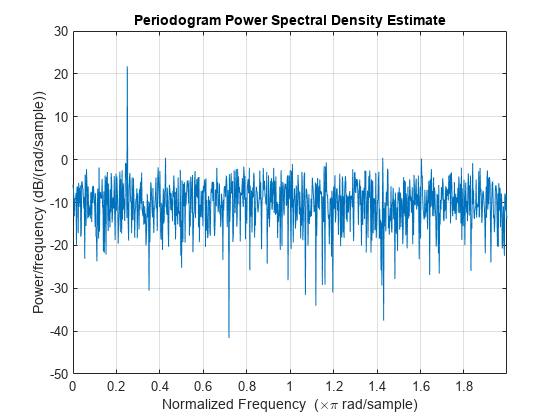使用 FFT 获得功率频谱密度估计
此示例说明如何使用 periodogram 和 fft 函数获得非参数化功率谱密度 (PSD) 估计。这些不同用例说明针对偶数长度输入、归一化频率和以赫兹表示的频率以及单边和双边 PSD 估计,如何正确缩放 fft 的输出。所有用例都使用矩形窗。
此示例重点介绍频率成分不随时间变化的平稳信号。对于频率成分随时间变化的非平稳信号,短时傅里叶变换是一种更好的分析工具。有关详细信息,请参阅Spectrogram Computation with Signal Processing Toolbox。
具有指定采样率的偶数长度输入
对于一个采样率为 1 kHz 的偶数长度信号,分别使用 fft 和 periodogram 获得其周期图。比较二者的结果。
创建一个含 N(0,1) 加性噪声的 100 Hz 正弦波信号。采样频率为 1 kHz。信号长度为 1000 个采样。
fs = 1000; t = 0:1/fs:1-1/fs; x = cos(2*pi*100*t) + randn(size(t));
使用 fft 获取周期图。信号是偶数长度的实数值信号。由于信号是实数值信号,您只需要对正负频率之一进行功率估计。为了保持总功率不变,将同时在两组(正频率和负频率)中出现的所有频率乘以因子 2。零频率 (DC) 和奈奎斯特频率不会出现两次。绘制结果。
N = length(x); xdft = fft(x); xdft = xdft(1:N/2+1); psdx = (1/(fs*N)) * abs(xdft).^2; psdx(2:end-1) = 2*psdx(2:end-1); freq = 0:fs/length(x):fs/2; plot(freq,pow2db(psdx)) grid on title("Periodogram Using FFT") xlabel("Frequency (Hz)") ylabel("Power/Frequency (dB/Hz)")

计算并使用 periodogram 绘制周期图。二者的结果相同。
periodogram(x,rectwin(N),N,fs)

mxerr = max(psdx'-periodogram(x,rectwin(N),N,fs))
mxerr = 3.4694e-18
具有归一化频率的输入
通过 fft 为使用归一化频率的输入生成周期图。创建一个带 N(0,1) 加性噪声的正弦波信号。该正弦波的角频率为 弧度/采样点。
N = 1000; n = 0:N-1; x = cos(pi/4*n) + randn(size(n));
使用 fft 获取周期图。信号是偶数长度的实数值信号。由于信号是实数值信号,您只需要对正负频率之一进行功率估计。为了保持总功率不变,将同时在两组(正频率和负频率)中出现的所有频率乘以因子 2。零频率 (DC) 和奈奎斯特频率不会出现两次。绘制结果。
xdft = fft(x); xdft = xdft(1:N/2+1); psdx = (1/(2*pi*N)) * abs(xdft).^2; psdx(2:end-1) = 2*psdx(2:end-1); freq = 0:2*pi/N:pi; plot(freq/pi,pow2db(psdx)) grid on title("Periodogram Using FFT") xlabel("Normalized Frequency (\times\pi rad/sample)") ylabel("Power/Frequency (dB/(rad/sample))")

计算并使用 periodogram 绘制周期图。二者的结果相同。
periodogram(x,rectwin(N),N)

mxerr = max(psdx'-periodogram(x,rectwin(N),N))
mxerr = 4.4409e-16
具有归一化频率的复数值输入
使用 fft 为具有归一化频率的复数值输入生成周期图。采用一个带 N(0,1) 复噪声的复指数信号,角频率为 弧度/采样点。
N = 1000; n = 0:N-1; x = exp(1j*pi/4*n) + [1 1j]*randn(2,N)/sqrt(2);
使用 fft 获得周期图。由于输入是复数值,此处求 弧度/采样点区间内的周期图。绘制结果。
xdft = fft(x); psdx = (1/(2*pi*N)) * abs(xdft).^2; freq = 0:2*pi/N:2*pi-2*pi/N; plot(freq/pi,pow2db(psdx)) grid on title("Periodogram Using FFT") xlabel("Normalized Frequency (\times\pi rad/sample)") ylabel("Power/Frequency (dB/(rad/sample))")

使用 periodogram 获取并绘制周期图。比较 PSD 估计。
periodogram(x,rectwin(N),N,"twosided")
mxerr = max(psdx'-periodogram(x,rectwin(N),N,"twosided"))mxerr = 2.2204e-16
另请参阅
App
函数
fft|periodogram|pspectrum